Toyota Century
| Toyota Century | |
|---|---|
_(cropped)).jpg) | |
| Overview | |
| Manufacturer | Toyota Motor Corporation |
| Production | 1967–present |
| Body and chassis | |
| Class | Full-size luxury car (F) |
| Body style | 4-door limousine |
| Layout | FR layout |
The Toyota Century (Japanese: トヨタ センチュリー Toyota Senchurī) is a large four-door limousine produced mainly for the Japanese market, serving as Toyota's flagship car within Japan; globally the unrelated Lexus LS series is Toyota's flagship luxury model outside Japan. Production of the Century began in 1967, and the model received only minor changes until a redesign in 1997. The Century derived its name from the 100th birthday of Sakichi Toyoda (born 14 February 1867), the founder of Toyota Industries. It is often used by the Imperial House of Japan, the Prime Minister of Japan, senior Japanese government leaders, and high-level executive businessmen. The Century is comparable in purpose to the Austin Princess/Daimler DS420, Cadillac Series 70, Mercedes-Benz 600, Chinese Red Flag, Rolls-Royce, and Russian ZIS/ZIL limousines. The first-generation Century was available with only a V8 engine, the third Japanese-built sedan post-war, at its introduction in 1967 until a full platform redesign in 1997. The second generation was only installed with a Toyota-designed and -built V12, an engine unique to the Century, until 2018, when the power-train was reverted to a V8 with the addition of Toyota's hybrid technology. While the Century is a premium, full-size luxury sedan, it is not available at Japanese Lexus dealerships; it can only be purchased at specifically identified Toyota Store locations. The logo used throughout is called the Hō-ō 鳳凰 or Fushichō from Asian mythology, representing the Imperial House of Japan.[1]
The exterior styling of the Century has, with some modifications, remained unchanged since its introduction, primarily due to its perception as denoting conservative success. Its appearance is iconic in Asian countries and is usually painted black. The closest Japanese competitor was the Nissan President, with a similar status reputation although, during the 1960s and '70s, the high market positioning was also shared with the Mitsubishi Debonair.[2] Other Japanese competitors introduced large sedans—the Isuzu Statesman de Ville and the Mazda Roadpacer (derived from General Motors-Australia products)—which were short-lived.
First generation (G20, G30, G40; 1967–1997)
| First generation[3] | |
|---|---|
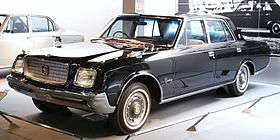 | |
| Overview | |
| Production | November 1967 – March 1997 |
| Assembly | Japan: Susono, Shizuoka (Higashi Fuji plant)[4] |
| Designer | Kenya Nakamura |
| Body and chassis | |
| Body style | 4-door limousine |
| Layout | FR layout |
| Powertrain | |
| Engine | |
| Power output | 112–142 kW (150–190 hp; 152–193 PS) |
| Transmission | |
| Dimensions | |
| Wheelbase |
|
| Length |
|
| Width | 1,890 mm (74.4 in) |
| Height | 1,430–1,460 mm (56.3–57.5 in) |
| Curb weight | 1,760–1,830 kg (3,880–4,030 lb) |
| Chronology | |
| Predecessor | Toyota Crown Eight de facto |
The original Century was based on the 1964 Crown Eight, which featured the 2.6 L V8 Toyota 3V engine, and appeared almost two years after the October 1965 introduction of the Nissan President with a 4.0 L V8. The 1967 Century was equipped with an upgraded version of the Crown Eight engine, the 3.0 L 3V. 1973 saw the introduction of the 3.4 L 4V-U, and the engine was once again changed to the 4.0 L 5V-EU in 1982, with the installation of fuel injection, and the installation of emission control technology Toyota called "TTC". Note that the 3V, 4V-U, and 5V-EU do not refer to the number of valves in the engine but simply denote model names in the Toyota V engine range.[5] On the "C" pillar there is a badge in blue with a gothic-style "C" for Century with a label "V8" below.
In 1971, automatic climate control became available, at that time a very innovative feature.[6]
The first generation Century remained largely untouched during its impressively long 30-year production run, apart from minor cosmetic changes and engine upgrades. The Century was produced in limited numbers and was built in a "nearly hand-made" fashion. In 1982 the Century received its first model change, updating the entire vehicle inside and out, and installing a larger engine. It is this appearance that has virtually remained unchanged to the current version, as the appearance of the Century introduced in 1982 is very much desired of its clientele. A fiber-optic multiplexing communications system was installed.[6]
During Japan's Bubble Economy, sales of the Century doubled (from 1,027 in 1985 to 2,117 in 1989).[7] But even the Century wasn't enough for these heady days of luxury, and in October 1989 the Century Limousine appeared. This was 650 mm (26 in) longer for an overall length of 5,770 mm (227.2 in), on a 3,510 mm (138.2 in) wheelbase, approximately the same dimensions as a Cadillac de Ville series, Lincoln Town Car, Mercedes-Benz S-Class, or a Rolls-Royce Silver Spirit. The Limousine also received a standard padded vinyl roof and an opera window in the centre pillar, where the stretch was placed. It also uses 150 mm wider rear doors, for a more balanced design and ease of entry. An annual production of 60 was planned.[7] As of September 1990 there was also an L-type stretched version of the Century — length is 5,270 mm (207.5 in) with a wheelbase of 3,010 mm (118.5 in); this model uses the same larger rear doors as were fitted to the Century Limousine.
A Toyota Century with a GT45 gas turbine and electric motor was shown as the Century gas turbine hybrid concept vehicle at the 1975 Tokyo Motor Show.[8]
First generation changes
- 1973: Electromagnetic locks were changed, the tail lights were changed as well as the inclusion of front disc brakes.
- 1975: Standard manual transmission no longer offered.
- 1987: On D-type, Transmission shifter moved from the column to the floor. Front bucket seats instead of bench seats.
Chassis codes
- VG20: 3.0 L 3V V8, 1967–1973
- VG21: 3.4 L 4V-U V8, 1973
- VG30: 3.4 L 4V-U V8, 1973–1977
- C-VG30: 1977
- E-VG35: 1978–1982
- VG40: 4.0 L 5V-EU V8, 1982–1997
- VG45: 4.0 L 5V-EU V8 (L-type) 1990-1997
- First generation (G20, G30, G40)
 1982 VG40 Century
1982 VG40 Century.jpg) Rear passenger area (Limousine VG45 series)
Rear passenger area (Limousine VG45 series).jpg) 1990 VG40 Century
1990 VG40 Century
Second generation (G50; 1997–2016)
| Second generation[9] | |
|---|---|
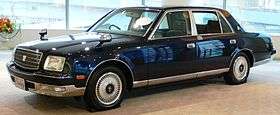 | |
| Overview | |
| Production | April 1997 – October 2016 |
| Assembly | Japan: Susono, Shizuoka (Higashi Fuji plant)[4] |
| Designer | Akira Shimizu |
| Body and chassis | |
| Body style | 4-door limousine |
| Layout | FR layout |
| Related | Toyota Century Royal |
| Powertrain | |
| Engine | 4.996 L (305 cu in) 1GZ-FE V12 |
| Power output | 206 kW (276 hp; 280 PS) |
| Transmission |
|
| Dimensions | |
| Wheelbase | 3,025 mm (119.1 in) |
| Length | 5,270 mm (207 in) |
| Width | 1,890 mm (74 in) |
| Height | 1,475 mm (58.1 in) |
| Curb weight | 1,990 kg (4,390 lb) |
The Century received a complete redesign in April 1997, although the new model was visually very similar to the previous generation. This model is powered by a 280 PS (206 kW; 276 hp) 5.0 L 1GZ-FE V12, initially with a 4-speed automatic, until a 6-speed "intelligent" transmission arrived in 2005. It also features air suspension. The Century remains the first and only Japanese front-engine, rear-wheel drive production car equipped with a V12, and it is Toyota's first V12 engine.[10] As this is a top level luxury flagship, private owners are comfortable with the yearly road tax bill.
The Century was Toyota's most luxurious model at its inception in 1967, and maintained this status throughout the 20th century. Today, it is positioned above the Lexus line-up, and remains the most luxurious and prestigious model to wear the Toyota badge. The Century shares the role of flagship with the Toyota Crown Majesta with almost identical dimensions to the Century but with a more modern approach and appearance that appeals to younger buyers, and both vehicles are exclusive to the Toyota Store dealership network in Japan. This generation no longer offered the ability to select which level of equipment preferred, designated as the D-Type, E-Type and the extended length L-Type of the previous generation, and changed to offering either a floor-mounted or column-mounted transmission selector.[11] From 2003 through 2004, the V12 engine was briefly offered the ability to use CNG fuel. On the "C" pillar there is a badge in blue with a gothic-style "C" for Century with a label "V12" below.
Like other cars in the top of the luxury class, the Century is designed with the rear passengers in mind. Hence, the rear seats recline and the front passenger seat has a fold-down center section so that a passenger in the back may stretch his feet forward. The rear seats are equipped with a massage system. The exterior door handles open the doors electrically since the sound of the door being opened mechanically is perceived as being "too obtrusive". The doors do not need to be closed directly, instead the door only needs to contact the latch, causing the door to pull itself completely closed electrically.[11]
The vehicles' interiors are usually ordered in wool cloth, rather than the leather seen in many luxury cars; leather is not as quiet as cloth when sat upon. The vehicle can be ordered in any color the purchaser desires, however, the interior colors are usually medium brown, light brown, burgundy, gray or royal blue inside, with a choice of five exterior colors including black. The Century is distinguished by different paint options than the rest of the Toyota line-up, and color choices have culturally significant names. They are (カムイ) Kamui Eternal Black, (摩周湖) Lake Mashū Shrine Blue Mica, (鸞) Rinpo Glorious Gray Metallic, (精華) Seika Radiant Silver Metallic and (彩雲) Seiun Cloud Demure Blue Mica Metallic.[12] Vehicles primarily intended for livery service usually have leather interiors in gray, for easier interior cleaning and durability. White lace curtains are usually installed in the rear window, instead of tinted windows, which are perceived to attract unwarranted attention. The passengers usually like to be seen in a Century, despite Asian tendencies for modesty.
The Century is priced at ¥11,445,000 (approximately US$100,000 as of 2009). In comparison, the base price for the full-size luxury 2008 Lexus LS 460 is approximately ¥10,000,000 (US$87,000),[13] with the LS 600h L at ¥15,000,000 (US$125,800).
In year 2006, the G-BOOK vehicle telematics subscription service was added to the list of standard features.
Although the Century is generally not exported, it is frequently used by Japanese diplomats overseas. Around 100 cars were produced with left-hand drive starting in 1998, and were exported to Europe, the Middle East and the United States for promotional and testing purposes.[14] Several were in use as corporate cars for Toyota's North American executives.[15]
In contrast to other luxurious cars (such as the Maybach or Rolls-Royce), the Century has not been positioned and marketed as a sign of wealth or excess. Marketing literature states roughly that, "the Century is acquired through persistent work, the kind that is done in a plain but formal suit."[16]
The second generation Century was discontinued on 4 February 2017, after almost 20 years of production.[17]
- Second generation (G50)
 1997 Century rear
1997 Century rear A Premium Century at the 2007 Tokyo Motor Show
A Premium Century at the 2007 Tokyo Motor Show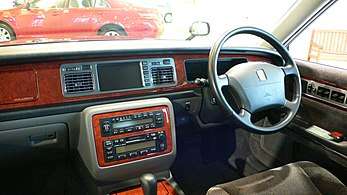 1997 Century driver's seat
1997 Century driver's seat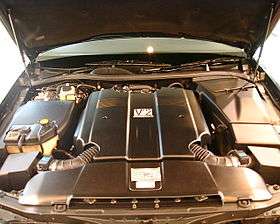 1GZ-FE V12
1GZ-FE V12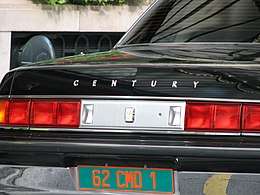 A Toyota Century used by the Japanese Ambassador to France, with French diplomatic license plates
A Toyota Century used by the Japanese Ambassador to France, with French diplomatic license plates
Toyota Century Royal (G51; 2006-2008)
| Toyota Century Royal | |
|---|---|
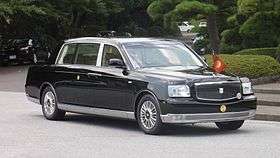 Empress 1 | |
| Overview | |
| Production |
|
| Body and chassis | |
| Body style | 4-door limousine |
| Layout | FR layout |
| Related | Toyota Century |
| Powertrain | |
| Engine | 4.996 L (305 cu in) 1GZ-FE V12 |
| Transmission | 6-speed automatic (6 Super ECT) |
| Dimensions | |
| Wheelbase | 3,510 mm (138 in) |
| Length | 6,155 mm (242.3 in) |
| Width | 2,050 mm (81 in) |
| Height | 1,770 mm (70 in) |
| Curb weight | 2,920 kg (6,440 lb) |
The Toyota Century Royal is the official state car currently used by the Emperor of Japan, being a specially prepared Toyota Century, a one-off ¥52,500,000 (US$500,000) custom car. The car was produced at the request of the Japanese Imperial Household Agency,[18] to be used by senior members of the Imperial House of Japan. This special version has wool cloth upholstery, internal granite entry steps and Japanese rice paper headlining for the passenger compartment, as well as undisclosed security measures. The front passenger compartment is upholstered in leather. With the introduction of the third generation Century in 2018, the tail lights on the Century Royal are vertical, while the civilian Century maintains horizontal tail lights across the back of the vehicle.
Five vehicles were originally ordered but, due to the individual cost for each, only four were built. According to the translation of the corresponding article on Japanese Wikipedia, one car, called Empress 1, is used by the Imperial Palace. Another was built as a hearse in 2008, known as Empress 2, and was used for the funeral of Prince Mikasa 27 October 2016.[19][20] Empress 3 and Empress 5 which, due to additional security equipment installed, cost ¥94,500,000 (US$851,445) each, are assigned to the Ministry of Foreign Affairs. The designation "Empress 4" is not used because the number 4 is considered unlucky. Each vehicle that is used for official transport is given a small round badge attached to the grille at the right, with the Kanji character representing "Empress" (Japanese:皇) along with an Arabic number.
The suspension consists of double wishbones for both the front and rear wheels, supplemented by air-bag support springs. The engine used is shared from the second-generation Toyota Century 5.0 L-V12 with horsepower rated at 280 PS (206 kW; 276 bhp) and 460 N⋅m (340 lbf⋅ft) at 4000rpm.[21] For various state functions, additional conventional Century sedans are used with a designated "Empress" number roundel.
This vehicle replaced the fleet of four 40-year-old Nissan Prince Royal limousines that were beginning to show their age. After the Prince Royals were no longer deemed appropriate by the Imperial Household Agency, the Emperor and Empress had been seen riding in a conventional Century until the Century Royals were ready for service. The Century Royal is exclusive to the Imperial Household and was presented for service on July 7, 2006. When the Emperor is riding inside, the Imperial Standard is displayed on the top of the grille. An additional roundel, known as the Imperial Seal of Japan is also displayed at both the front and rear of the car in place of a license plate, and on the exterior of both rear passenger doors, displaying a 16-petal chrysanthemum in golden colour, denoting the Chrysanthemum Throne of Japan.
The limousine stretches around 20 feet in length and 6.5 feet across,[22] —the same length as a Maybach 62 and both longer and heavier than a 2003 Rolls-Royce Phantom. The Emperor was previously driven in a Nissan Prince Royal (1967–2008), Cadillac Series 75 (1951–1970), Mercedes-Benz 770 W07 Series (1932–1968), Rolls-Royce Silver Ghost (1921–1936), Daimler (1913–1927).
Chassis codes
- Toyota Century Royal (G51)
.jpg) The Emperor in a conventional Century labeled Empress 8
The Emperor in a conventional Century labeled Empress 8
Third generation (G60; 2018–present)
| Third generation | |
|---|---|
 | |
| Overview | |
| Production | June 2018 – present |
| Assembly | Japan: Susono, Shizuoka (Higashi Fuji plant) |
| Body and chassis | |
| Body style | 4-door limousine |
| Layout | FR layout |
| Powertrain | |
| Engine | 4.968 L (303 cu in) 2UR-FSE V8 |
| Power output |
|
| Transmission | eCVT[23] |
| Dimensions | |
| Wheelbase | 3,090 mm (122 in) |
| Length | 5,335 mm (210.0 in)[23] |
| Width | 1,930 mm (76 in)[23] |
| Height | 1,505 mm (59.3 in)[23] |
| Curb weight | 2,370 kg (5,220 lb)[23] |
The third generation Century was unveiled at the October 2017 Tokyo Motor Show.[24] The car then went on sale on 22 June 2018, with prices starting from ¥19,600,000[23] (approximately US$180,000 at June 2018 exchange rates) to the top grade Century Limousine at ¥60,000,000. It is to be offered in four exterior colors, with culturally significant names; (神威) Kamui Eternal Black, (摩周) Lake Mashū Shrine Blue Mica, (飛鳥) Asuka (Black Ash) Red Mica, and (精華) Seika Radiant Silver Metallic.[25]
It shows that its appearance was influenced by the Century Royal, which was produced at the request of the Japanese Imperial Household Agency to be used by senior members of the Imperial House of Japan in 2006.[26] The full model update maintains the visual tradition of the Century model, while incorporating appropriate technological upgrades and advances such as Toyota Safety Sense P-series collision avoidance support, and Toyota T-Connect.[27] The traditionally installed side-view mirrors above the front wheels, a standard feature that started with the first generation, have been replaced with door mounted units, incorporating turn signal lights. Unlike other Toyota products, which have the Toyota badge, and hybrid installed vehicles with a separate "hybrid badge" with an additional Toyota or Lexus badge with a blue background, the Century has the traditional Fushichō badge and the word "Century" in block letters on the trunklid and does not carry the Toyota badge or designation. On the "C" pillar there is a badge in blue with a gothic-style "C" for Century with a label "hybrid" below. This badge is a traditional Century styling feature that first appeared in 1967.
There are many features that are exclusive to the Century. The grille is the classic narrow vertical chrome strips with a second layer underneath of interlocking circles that are also used for the turn signals used in the front bumper. The rear taillights are also a traditional appearance which debuted with the first generation in 1967. As with previous generations, rear passenger comfort and convenience is made a priority. The rear seats have a recline feature, with integrated heaters and massage function, as well as an adjustable power leg rest for the rear seat opposite the driver. The sound system comes standard with 20 speakers. A 20-inch LCD screen is installed for rear seat passengers that let occupants control many aspects and features as a convenience as well as playing video content. The standard upholstery fabric continues to be offered in three color choices using 100% wool with a unique heather pattern, with leather remaining available optionally in two different color combinations. Both upholstery choices include two different wood inlay selections. The transmission selector, which on previous generations was either floor mounted or steering column installed, is now only available on the floor.
It is equipped with a 5.0-liter 2UR-FSE V8 engine part of the Toyota Hybrid System II, maintaining the previous displacement of the V12 engine with the convenience of an electric powertrain in urban driving environments and fuel expense savings, with a fuel economy of 13.6 km/L (38 mpg‑imp; 32 mpg‑US), while the previous generation had 10 km/L (28 mpg‑imp; 24 mpg‑US). The powertrain package was originally installed in the 2008-2017 Lexus LS 600h & LS 600h L; with the introduction of the XF50 series Lexus LS which no longer offers a V8 engine, this powertrain will now be unique to the Century.[28] The suspension has been upgraded from the previous double wishbone to a multi-link suspension with supplemental air bags to further enhance ride quality. Toyota first displayed a hybrid engine in the Century at the 1975 Tokyo Motor Show in the Century gas turbine hybrid, with a GT45 gas turbine and electric motor.[8]
Century GRMN
On 18 September 2018, the website Japanese Nostalgic Car published an article showing photos of a factory appearance package for the Century, called the Century GRMN (Gazoo Racing Masters of the Nürburgring). It is not clear whether this will be a one-off or not.[29] On 20 September 2018, an article was published by Japanese website Response showing President of Toyota Motors Akio Toyoda getting into his personally modified Century, which didn't appear to be the same as the conventional model currently available. The website suggested that a sport-oriented version of the Century might be offered soon.[30]
Chassis codes
- Toyota Century (G60)
 Toyota Century front
Toyota Century front Toyota Century with doors open
Toyota Century with doors open
See also
References
- ↑ Schumacher, Mark (2011-08-27). "Hou-ou (or Hoo-oo)—the Japanese Phoenix". Onmark Productions. Retrieved 2016-11-05.
- ↑ "Mitsubishi Automotive History" (Press release). South Africa: Mitsubishi. Archived from the original on 2008-09-22. Retrieved 2013-05-21.
- ↑ Toyota Century, Japanese sales brochure, circa 1990
- 1 2 "Affiliates (Toyota wholly-owned subsidiaries)-Toyota Motor East Japan, Inc". Toyota. 2012. Retrieved 2014-07-15.
- ↑ "トヨタ センチュリー | 世代別モデル一覧" [Toyota Century | Generation model list]. Toyota. Retrieved 2017-10-21 – via Gazoo.
- 1 2 "75 Years of Toyota - Technical Development - Electronics Parts". Toyota. 2012. Retrieved 2017-02-10.
- 1 2 Tazawa (田澤), Kōichi (晃一), ed. (1997). 絶版車カタログ 国産車編 Part5 1980~1989 [Japanese Historic Car Graffiti: Car Catalog part 5, 1980–1989]. Eichi Mook (in Japanese). Tokyo: Eichi Publishing (英知出版). p. 5. ISBN 4-7542-5120-2.
- 1 2 Toyota brochure from the 1975 Tokyo Motor Show (Japanese)
- ↑ Toyota Century (second generation), Japanese sales brochure, #TB0018-0105 (2001)
- ↑ "75 Years of TOYOTA | Technical Development | Engines". Toyota. 2012. Retrieved 2015-01-02.
- 1 2 "Toyota Century Catalog". Goo-Net. Proto Corporation. Retrieved 2017-10-08.
- ↑ "2013 Toyota Century catalog" (PDF). Toyota Century Catalog. Toyota Motor Corporation. 2013. Retrieved 2017-10-08.
- ↑ Schreffler, Roger; Chrysler, Mack (2006-12-28). "Lexus Slowly Progressing in Japan". WardsAuto. Retrieved 2013-05-21.
- ↑ "トヨタ自動車 製品企画本部 センチュリー 開発主査 清水 勉 インタビュー(5/5)|NEXTALK【オートックワン】". オートックワン (in Japanese). Retrieved 2018-08-03.
- ↑ Motavalli, Jim (2005-01-30). "What the Heck Was That Crazy Car?". The New York Times. US. Retrieved 2018-07-13.
- ↑ "Perpetual Classic: 2013 Toyota Century: The Ultimate Brougham Time Machine". Curbside Classic. 2013-05-20. Retrieved 2013-05-21.
- ↑ Hsu, Ben (2017-10-05). "NEWS: Toyota will introduce a new Century for only the third time in 50 years". Japanese Nostalgic Car. Retrieved 2017-10-05.
- ↑ "Goryō new vehicles - the Imperial Household Management Division" (in Japanese). 2006-07-12. Retrieved 2009-11-14.
- ↑ トヨタ センチュリー ロイヤル 寝台車 [Toyota Century Royal hearse]. Retrieved 2017-10-15 – via YouTube.
- ↑ Iwasaki, Koyata (2016-02-22). "Toyota Century Royal hearse". Retrieved 2017-10-15 – via Wheelsage.
- ↑ "センチュリー フロアシフト(2014年4月) のカタログ情報" [Century Floor Shift (April 2014) Catalogue]. Goo-net.com. Proto. Retrieved 2017-10-16.
- ↑ "Toyota gives emperor the Century Royal treatment". Windingroad.com. 2006-07-13. Retrieved 2007-08-29.
- 1 2 3 4 5 6 7 "TOYOTA CENTURY catalog - reviews, pics, specs and prices". Goo-net Exchange. Japan. 2018. Retrieved 2018-07-03.
- ↑ "2018 Toyota Century". Toyota Global Newsroom. Toyota Motor Corporation. Retrieved 2017-10-27.
- ↑ "トヨタ 新型 センチュリーハイブリッド 最高級フラッグシップモデルは2018年6月フルモデルチェンジ" [Toyota's flagship Century hybrid to be fully remodelled in June 2018]. Kuruma GT (in Japanese). Japan. 2018-03-18. Retrieved 2018-03-31.
- ↑ "2018 Toyota Century". Net Car Show. Retrieved 2017-10-05.
- ↑ Toyota's Rolls-Royce for half the money - the incredible 2018 Century. 2017-10-27. Retrieved 2017-10-28 – via YouTube.
- ↑ Hsu, Ben (2017-10-05). "NEWS: Toyota will introduce a new Century for only the third time in 50 years". Japanese Nostalgic Car. Retrieved 2017-10-05.
- ↑ "NEWS: Akio Toyoda actually built a Century GRMN". Japanese Nostalgic Car. Japanese Nostalgic Car. Retrieved 2018-09-22.
- ↑ "トヨタ センチュリー GRMN、世界に1台しかない豊田章男社長専用車がサプライズ登場…市販化は?" [Toyota Century GRMN, only one in the world President Akio Toyoda President appeared Surprise ... What about commercialization?]. Response. IID Incorported. Retrieved 2018-09-22.
External links
| Wikimedia Commons has media related to Toyota Century. |